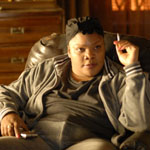

By Mike Wilmington Wilmington@moviecitynews.com
Wilmington: The National Film Critics Awards
This year’s big winner at the 2009 voting awards meeting of the National Society of Film Critics, the 44th in its genuinely storied annals, was Kathryn Bigelow’s Iraq War drama The Hurt Locker. Already  festooned with prizes, Hurt Locker took home the NSFC awards for Best Picture, Best Director (Bigelow) and Best Actor (Jeremy Renner as the seemingly hard-as-nails bomb-squad chief). The Hurt Locker also barely missed a fourth prize, when the movie’s cinematographer Barry Ackroyd fell by a single poin, to Christian Berger, photographer on Michael Haneke’s The White Ribbon.
festooned with prizes, Hurt Locker took home the NSFC awards for Best Picture, Best Director (Bigelow) and Best Actor (Jeremy Renner as the seemingly hard-as-nails bomb-squad chief). The Hurt Locker also barely missed a fourth prize, when the movie’s cinematographer Barry Ackroyd fell by a single poin, to Christian Berger, photographer on Michael Haneke’s The White Ribbon.
Other major winners included France’s Yolande Moreau, named Best Actress (in any language), by a single point over the inevitable Meryl Streep (for both Julie and Julia and Fantastic Mr. Fox). Moreau won for her title role in the French Seraphine, Martin Provost’s heartbreaking real-life bio portrait of Seraphine de Senlis, an impoverished provincial housekeeper who was also a brilliant French naïve painter.
And they also included the sometimes inevitable brothers Joel and Ethan Coen, who won the Best Screenplay scroll for A Serious Man, their acerbic and controversial comedy about a Jewish Midwestern family in the ’60s; and the French genius Olivier Assayas’ brainy and compassionate family ensemble drama Summer Hours, which won the Best Foreign Language Picture prize. Hours also nailed the runner-up slot for Best Picture (overall), and won Assayas two more second place citations, for both best Director and Best Screenplay.
Bigelow’s wins were huge. Hurt Locker won Best Picture by 41 points (64 to 23) over Summer Hours, and Bigelow beat Assayas for Best Director by a whopping 62 points (85-23). Summer Hours meanwhile beat its own Foreign Language Picture runner-up, Everlasting Moments (another favorite of mine, Jan Troell’s beautiful Swedish bio-drama about another beleaguered woman artist, the photographer Maria Larsson), by 40 points (61-21). Most of the other races were close or even razor-thin.
 The Best Supporting Actress award went, as expected, to Mo’Nique (by four points over the tied runners-up, Up in the Air’s fire-’em’-all go-getter Anna Kendrick and The Messenger’s quiet Iraq war widow Samantha Morton), for Mo’Nique’s role as the dysfunctional and destructive mother of Precious. In the afternoon’s tightest race, the Best Supporting Actor nod was split in another tie at 28 points apiece between Christophe Waltz as the urbane Nazi fugitive-Jew-hunter of Inglourious Basterds, and Paul Schneider as Keats patron-admirer Charles Armitage Brown in Jane Campion’s John Keats-Fanny Brawne bio-romance, Bright Star. Christian McKay, my own personal pick in this category for his tour-de-force job as the young Orson Welles in Me and Orson Welles, finished only a point behind them, with 27.
The Best Supporting Actress award went, as expected, to Mo’Nique (by four points over the tied runners-up, Up in the Air’s fire-’em’-all go-getter Anna Kendrick and The Messenger’s quiet Iraq war widow Samantha Morton), for Mo’Nique’s role as the dysfunctional and destructive mother of Precious. In the afternoon’s tightest race, the Best Supporting Actor nod was split in another tie at 28 points apiece between Christophe Waltz as the urbane Nazi fugitive-Jew-hunter of Inglourious Basterds, and Paul Schneider as Keats patron-admirer Charles Armitage Brown in Jane Campion’s John Keats-Fanny Brawne bio-romance, Bright Star. Christian McKay, my own personal pick in this category for his tour-de-force job as the young Orson Welles in Me and Orson Welles, finished only a point behind them, with 27.
France’s great venerable New Wave veteran Agnes Varda very deservedly won the Best Nonfiction Film prize for her lyrical personal life chronicle The Beaches of Agnes (by 10 points over James Toback’s much rougher Iron Mike bio-doc, Tyson), while the prize for Best Production Design went to Nelson Lowry for Wes Anderson’s whimsical puppet film, Fantastic Mr. Fox. Six highly treasurable films or DVD sets were cited for the group’s Film Heritage Award. (See below.)
Quentin Tarantino’s critics’ darling World War Two thriller Inglourious Basterds got votes in a number of categories, but finished no higher than third, for both Best Picture, and Best Screenplay (Tarantino). Avatar won only a second place mention, for Rick Carter’s production design. But Anderson’s Fantastic Mr. Fox won not only for Lowry’s design, but finished second for Best Actress (Streep, for both Fox and Julia) and third for Best Director (Anderson, who nosed out Tarantino).
Usually there’s one award vote that gets me a little riled, and this year it was in the Best Actor contest. Jeremy Renner, who has already won several other critics’ prizes (including Chicago’s), beat out his main competitor, Jeff Bridges (much-awarded also as the alcoholic C & W star in Crazy Heart) by only four points, and the reason Renner won was less a matter of consensus than from a glitch in the rules.
Bridges, my favorite this year, had a huge advantage in the pre-counted proxy votes. But NSFC rules require proxies to drop out if the first ballot leader doesn’t get a plurality of voters on the first ballot, and Bridges missed by one vote. When all the proxies went, the 20 people left around the table in the Sardi’s banquet room made the final decision. I have never liked this rule — I think proxies should remain in play until the vote is decided — but it’s a longstanding NSFC tradition.
Mind you, I think Renner did a tremendous job in Hurt Locker, and that he deserves his plaudits, prizes, and a lock on an Oscar nomination. But I don’t think he was better than Bridges. I also don’t think he was better than Nic Cage, as the wild man, pill-popping cop in Bad Lieutenant: New Orleans Port of Call. But that’s what makes horse races. And that’s why these confabs are fun. (Another reason: the stream of wisecracks from ex-chair Peter Rainer and current chair David Sterritt.)
Every year (but one) since 1987, I return to the NSFC meetings with fond memories. I love those get-togethers and I volunteer at them for every chore I can. But in the last few years, it’s been a sad experience. Movie critics keep getting let go, or forced out, or trashed by the failing newspaper industry and its up-in-the-air terminators and hit-creeps, and the organization that once boasted a yearly replay of the epic battles between Pauline Kael and her Paulettes and Andy Sarris and his Sarrisites, seems more and more depleted and under fire — though the people left by now have become for me mostly treasured personal friends. We’ve all been to the wars together, though the battles recently have been pretty bloody.
Goodbye for another year, NSFC. Love ya.
The Official National Society of Film Critics Vote Tally
BEST PICTURE
*1. The Hurt Locker (64) (U.S.: Kathryn Bigelow)
2. Summer Hours (23) (France: Olivier Assayas)
3. Inglourious Basterds (17) (U.S.: Quentin Tarantino)
BEST DIRECTOR
*1. Kathryn Bigelow (85) (The Hurt Locker)
2. Olivier Assayas (23) (Summer Hours)
3. Wes Anderson (18) (Fantastic Mr. Fox)
BEST ACTRESS
*1. Yolande Moreau (22) (Séraphine)
2. Meryl Streep (21) (Julie & Julia and Fantastic Mr. Fox)
3. Abbie Cornish (19) (Bright Star)
BEST ACTOR
*1. Jeremy Renner (30) (The Hurt Locker)
2. Jeff Bridges (24) (Crazy Heart)
3. Nicolas Cage (15) (Bad Lieutenant)
BEST SUPPORTING ACTRESS
*1. Mo’Nique (28) (Precious)
2. Anna Kendrick (24) (Up in the Air)
2. Samantha Morton (24) (The Messenger)
BEST SUPPORTING ACTOR
*1. Christoph Waltz 28 (Inglourious Basterds)
*1. Paul Schneider 28 (Bright Star)
3. Christian McKay 27 (Me and Orson Welles)
BEST FOREIGN LANGUAGE FILM
*1. Summer Hours 61 (France: Olivier Assayas)
2. Everlasting Moments 21 (Sweden: Jan Troell)
3. Police, Adjective 20 (Romania: Corneliu Porumboiu)
3. 35 Shots of Rum 20 (France: Claire Denis)
BEST NONFICTION FILM
*1. The Beaches of Agnes 40 (France: Agnes Varda)
2. Tyson 30 (U.S.: James Toback)
3. Anvil! The Story of Anvil 25 (U.S.: Sacha Gervasi)
BEST SCREENPLAY
*1. Joel and Ethan Coen 33 (A Serious Man)
2. Olivier Assayas 25 (Summer Hours)
3. Quentin Tarantino 22 (Inglourious Basterds)
BEST CINEMATOGRAPHY
*1. The White Ribbon 33 (Christian Berger)
2. The Hurt Locker 32 (Barry Ackroyd)
3. Everlasting Moments – 19 (Jan Troell, Mischa Gavrjusjov)
BEST PRODUCTION DESIGN
*1. Nelson Lowry 43 (Fantastic Mr. Fox)
2. Rick Carter 28 (Avatar)
3. Henry Selick 12 (Coraline)
FILM HERITAGE AWARD
Restoration of Akira Kurosawa’s Rashomon by Academy Film Archive, the National Film Center of the National Museum of Modern Art, Tokyo, and Kadokawa Pictures, Inc.
Bruce Posner for restoration of Manhatta .
Treasures from American Film Archives, Vol. 4: Avant Garde 1947-1986 (National Film Preservation Foundation).
Warner Archive Collection.
UCLA Film &Television Archive for its restoration of The Red Shoes.
Kino International Avant-Garde Volume 3 (Experimental Cinema 1922-1954).
– Michael Wilmington
January 3, 2010













